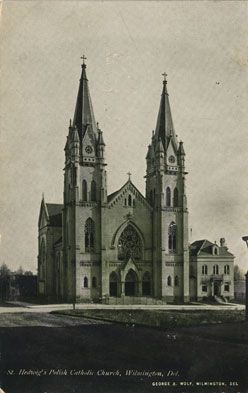About Our Parish
Our Patron: St. Hedwig
Duchess and widow, the patroness of Silesia, a region of eastern Europe. Also called Jadwiga in some lists, she died in a Cistercain convent, having taken vows. Hedwig was born in Andechs, Bavaria, Germany, the daughter of the Duke of Croatia and Dalmatia. She was the aunt of St. Elizabeth of Hungary. At the age of twelve, Hedwig was married to Duke Henry of Silesia, the head of the Polish Royal family. She bore him seven children, and they had a happy marriage. Henry founded a Cistercain convent at Trebnitz, as well as hospitals and monasteries. Henry died in 1238 and Hedwig became a Cistercain at Trebnitz. She had to leave her prayers to make peace among her offspring, and she buried a child who was killed fighting against the Mongols. She died in the convent on October 15. Many miracles were reported after her death, and she was canonized in 1266.

Parish History - How We Started
“The latest addition to the city’s churches is St. Hedwig’s at Linden & Harrison Streets, recently dedicated
with a church building that for beauty and striking architecture is unsurpassed.”
- from Conrad’s History of Delaware, 1908
The earliest Polish immigrants of our city came mostly from the Prussian partition of Poland. Arriving in Wilmington in the later part of the nineteenth century, they were attracted to Sacred Heart Parish, which was staffed by German Benedictine priests. Realizing the need to minister full time to the growing Polish population, the Benedictine priests purchased two plots of land at the intersection of Linden and Harrison Streets.
The new parish was founded in October of 1890 and placed under the patronage of Saint Hedwig, the thirteenth century Duchess of Poland and Patroness of Silesia. Father Richard Aust, O.S.B. was our first pastor. The original building that served as both the church and school was built on the site of the present parking lot. It soon became too small to accommodate the swelling crowds that were immigrating to this area.

Taking over from the Benedictine administration, Rev. John S. Gulcz appointed a committee on June 30, 1899 for raising money to erect a new church. On November 9, 1899, plans were added to erect a new parsonage (rectory) at the same time. A then staggering amount of $90,000 was needed to complete the church and rectory. A collection of donations began with monthly door-to-door canvassing throughout the neighborhood. The area was divided into several districts and the smallest acceptable donation was one dollar a month. A total of $30,000 was collected and a loan was taken from the Equitable Guarantee and Trust Company in the amount of $60,000. It was paid in full on the eve of the Great Stock Crash, October 15, 1929.
Admiring a newly built church in Brooklyn, Father Gulcz hired the same architect, Brilmaier & Sons of Milwaukee, to design the church and rectory. The church is neo-Gothic in style. Massive granite forms the foundation, while the walls are of gray brick. Trimmings are of cut Bedford stone and galvanized iron, while Bangor quarry slate covered the roof. Its twin towers rise to a height of 135 feet, and a third steeple, smaller in size, was erected above the transept. It is the only church in the Diocese of Wilmington and the State of Delaware with twin towers.
The cornerstone laying ceremony took place on Sunday, July 3, 1904 at 3:30 p.m. Visitors from Chester & Philadelphia were met at the wharf of the Wilmington Steamboat Company by the various Church societies. A large parade was formed and marched to the bishop’s home at 3rd and Jackson Streets, proceeding to the old church on Linden Street, then to the site of the present church. The cornerstone was blessed and set by Bishop John J. Monaghan and assisted by Father Gulcz.
The headline for an article appearing in the April 3, 1905 edition of The Journal Every Evening read, “Thousands Witness Dedication of Church.” The dedication of St. Hedwig Church began with a solemn procession from the Rectory to the new church. The congregation circled the building as Bishop onaghan sprinkled the walls with holy water. Once inside, the interior walls and the sanctuary were blessed & consecrated. The dedication was followed by High Mass and then by Forty Hours Devotion. A full orchestra accompanied the choir of 50 voices, selected from several Catholic choirs throughout the city.
(Originally compiled by Rev. Joseph Piekarski and Edward A. Lipka)





